The Daily Shot: 17-Feb-21
• The United States
• The United Kingdom
• The Eurozone
• Japan
• Asia – Pacific
• China
• Emerging Markets
• Cryptocurrency
• Commodities
• Energy
• Equities
• Credit
• Rates
• Global Developments
• Food for Thought
The United States
1. The New York Fed’s manufacturing index (Empire) showed robust factory activity in the region this month.
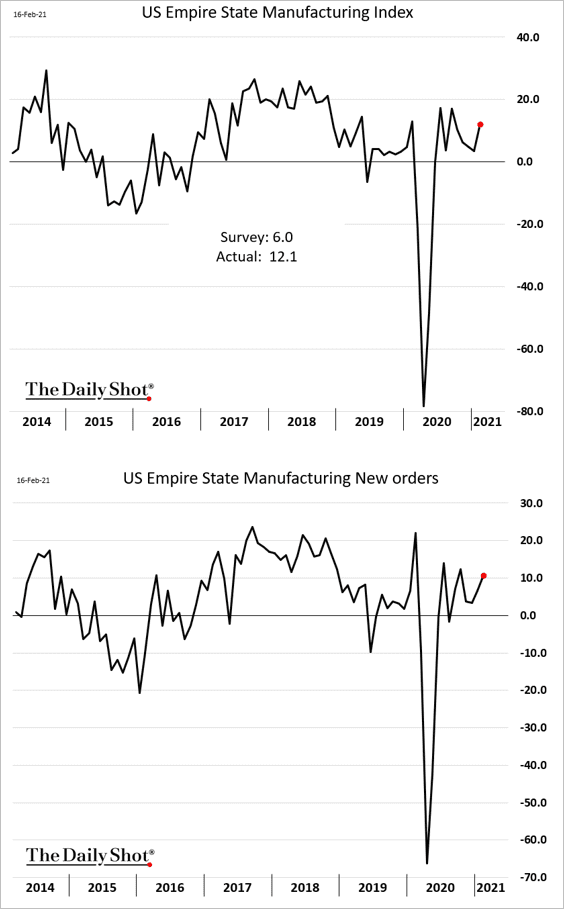
Manufacturers are upbeat on future business spending.
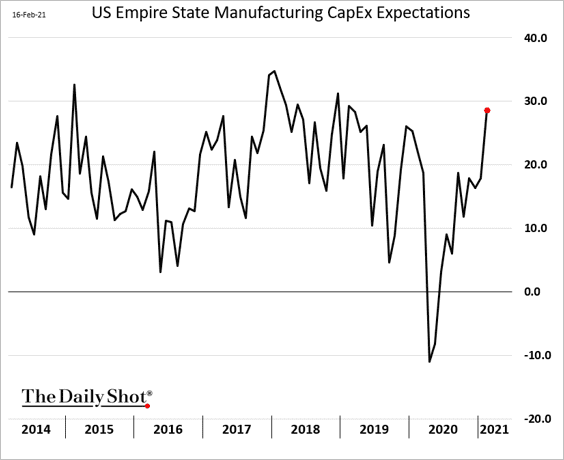
Input costs are rising quickly, and businesses are boosting sales prices. But the spread between input and output price indices keeps widening. Will we see some margin pressures?
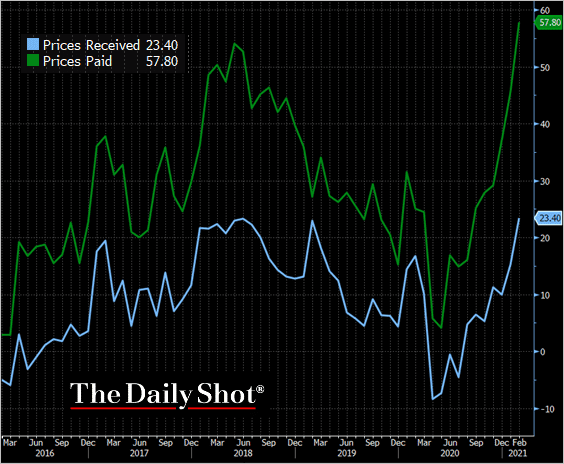 Source: @TheTerminal, Bloomberg Finance L.P.
Source: @TheTerminal, Bloomberg Finance L.P.
Empire prices paid point to a stronger US goods PPI, …
 Source: Pantheon Macroeconomics
Source: Pantheon Macroeconomics
… while output prices indicate higher consumer inflation.
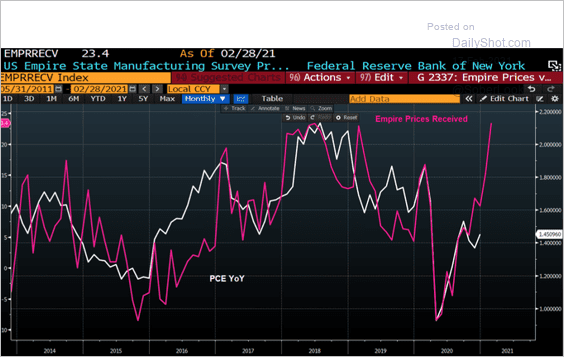 Source: @JulianMI2, @TheTerminal
Source: @JulianMI2, @TheTerminal
We are starting to see some of these trends showing up in the news.
 Source: Reuters Read full article
Source: Reuters Read full article
——————–
2. For the first time in years, the market is bullish on inflation.
• Breakeven rate:
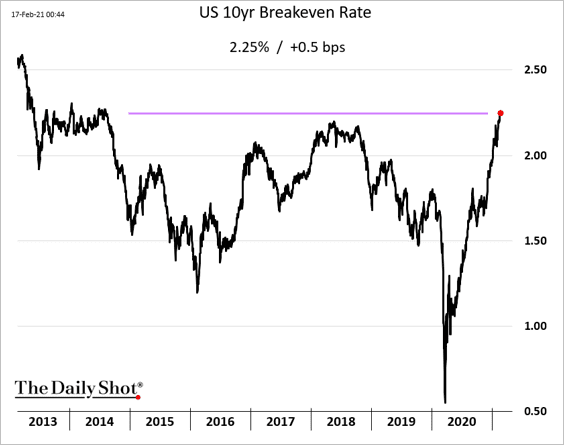
• The stock market (2 charts):
– Inflation-sensitive stocks:
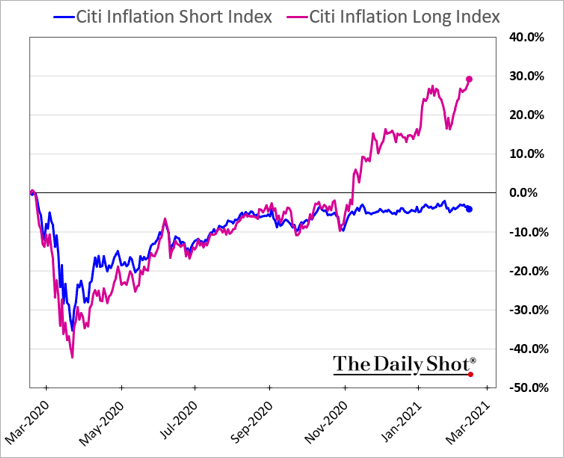
– ETF flows:
 Source: Arbor Research & Trading
Source: Arbor Research & Trading
——————–
3. Treasury yields continue to climb. The bond rout is not limited to the US, with the selloff hitting major government debt markets worldwide.
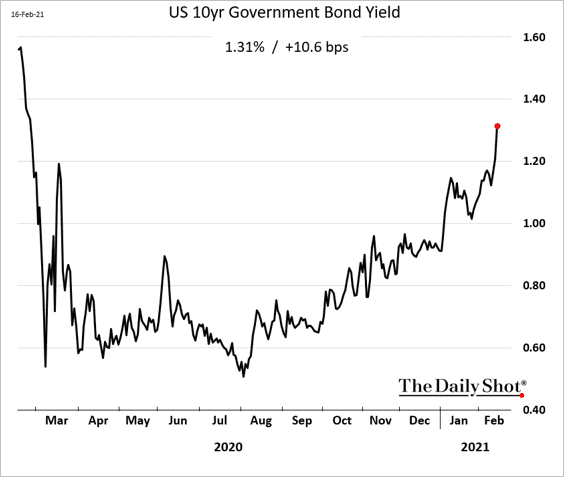
4. US job postings continue to climb.
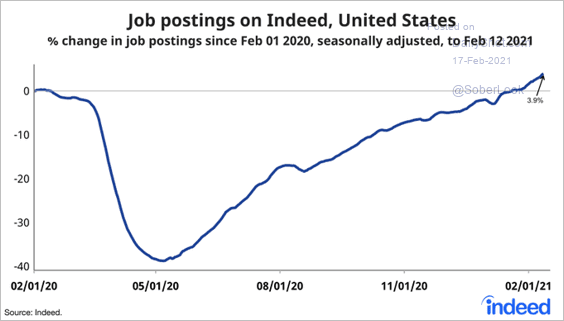 Source: @JedKolko
Source: @JedKolko
5. The latest round of stimulus checks boosted credit/debit card spending.
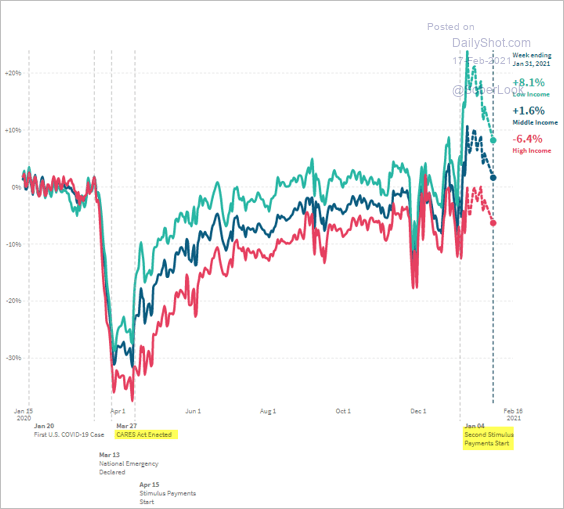 Source: Opportunity Insights
Source: Opportunity Insights
6. B2B spending is also up strongly.
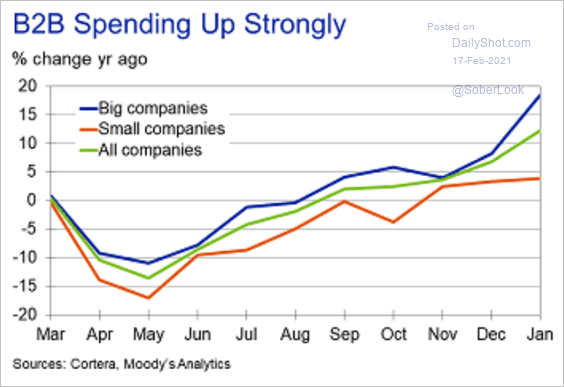 Source: Moody’s Analytics
Source: Moody’s Analytics
7. Here is the breakdown of the recent burst in imports.
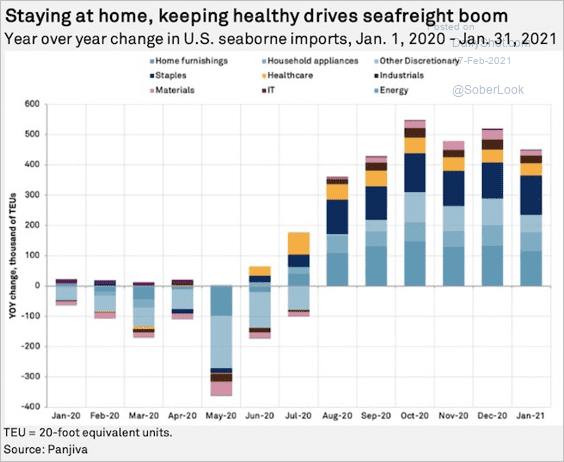 Source: S&P Global Market Intelligence
Source: S&P Global Market Intelligence
8. The COVID situation continues to improve.
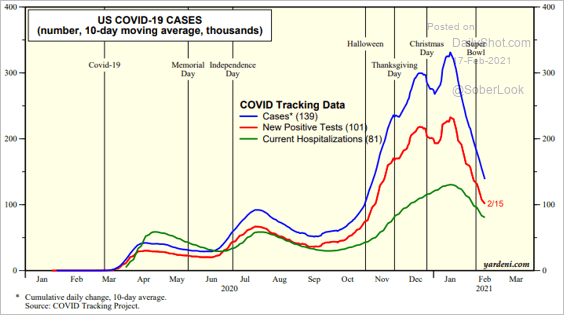 Source: Yardeni Research
Source: Yardeni Research
Back to Index
The United Kingdom
1. Longer-term rates are rising rapidly, which is a global trend now.

2. The pound continues to climb. EUR/GBP broke support and just kept going.
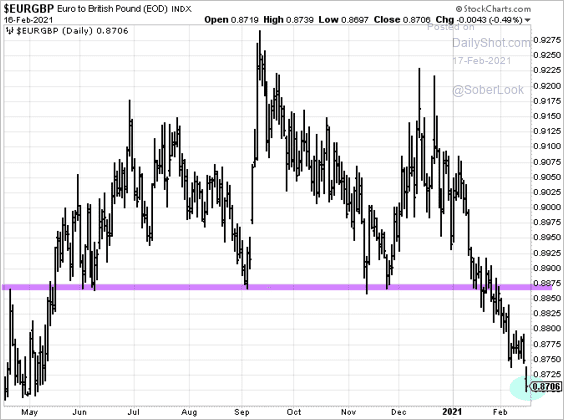
3. As we see in the US, manufacturers’ input prices are climbing, potentially putting pressure on margins.
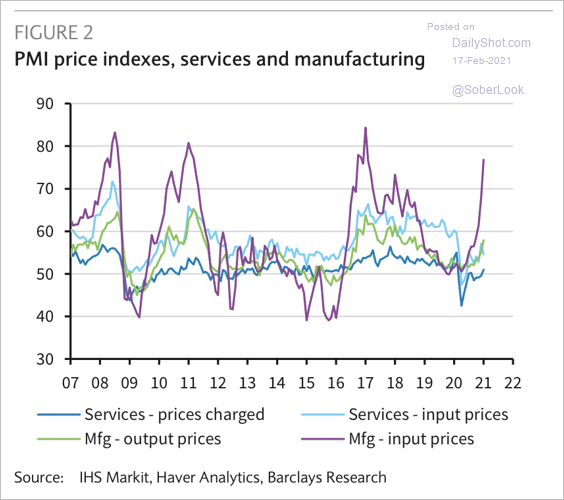 Source: Barclays Research
Source: Barclays Research
4. The number of self-employed workers has dropped off sharply.
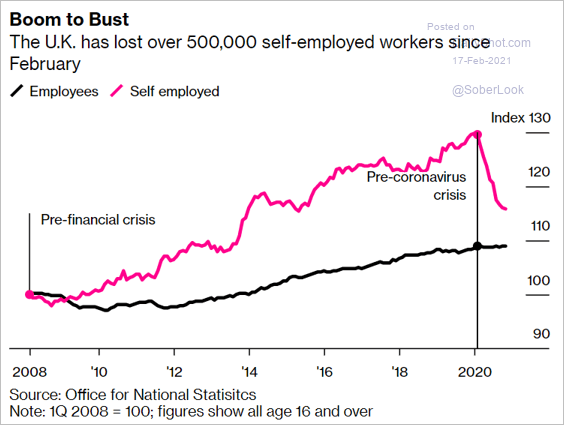 Source: @markets Read full article
Source: @markets Read full article
5. London is losing its status as the leading financial hub.
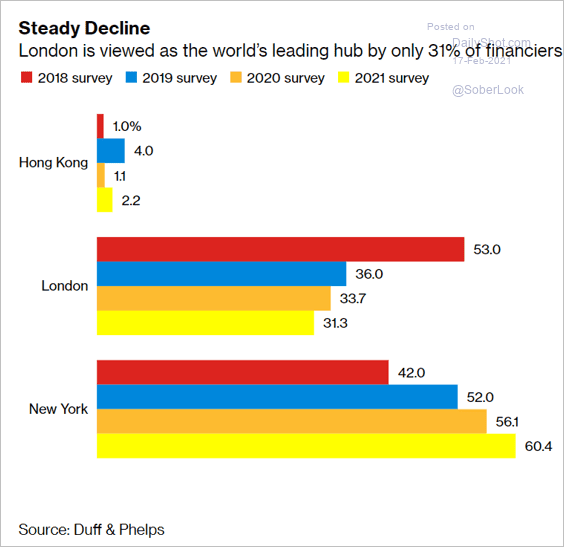 Source: @markets Read full article
Source: @markets Read full article
6. Britons support keeping social distancing in place until autumn.
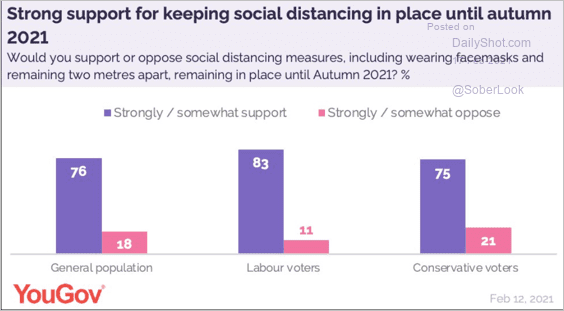 Source: @YouGov Read full article
Source: @YouGov Read full article
Back to Index
The Eurozone
1. The French unemployment rate unexpectedly declined last quarter.
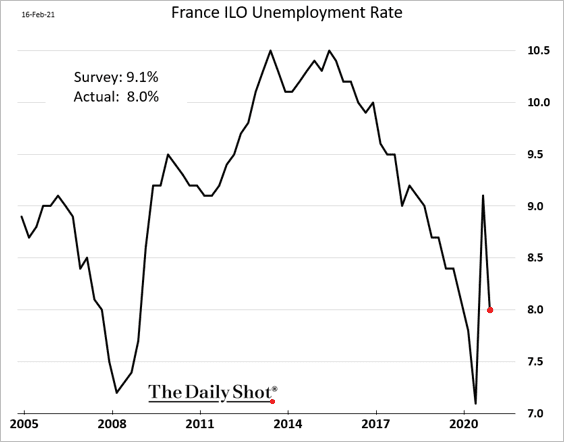
Here are the year-over-year changes in the euro-area total employment.
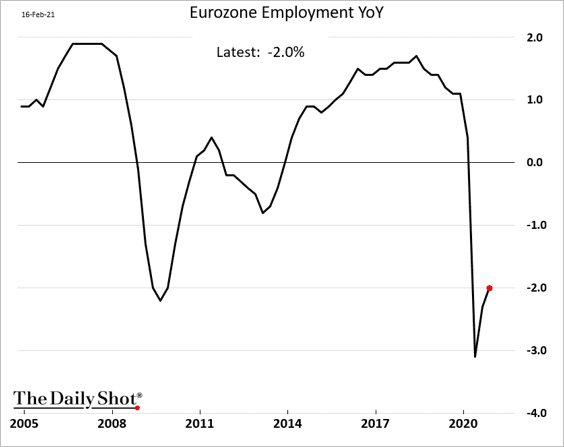
——————–
2. The Netherlands’ GDP declined last quarter (“double-dip”), pressured by weak consumer spending (2nd chart).
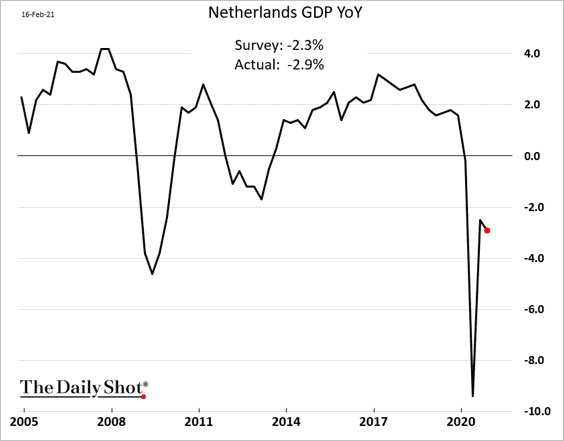

——————–
3. Germany’s ZEW expectations indicator jumped this month, exceeding estimates. Financial market experts are confident about the nation’s economic rebound.
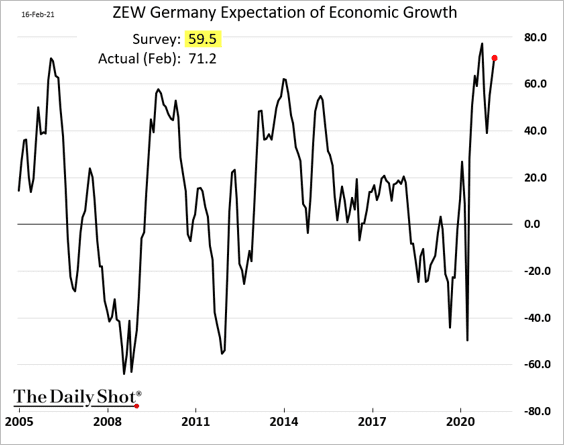
4. Italian GDP continues to lag the rest of the Eurozone.
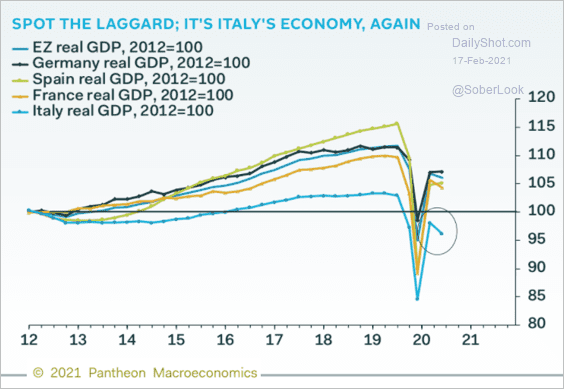 Source: Pantheon Macroeconomics
Source: Pantheon Macroeconomics
Italian bond spreads are at multi-year lows.
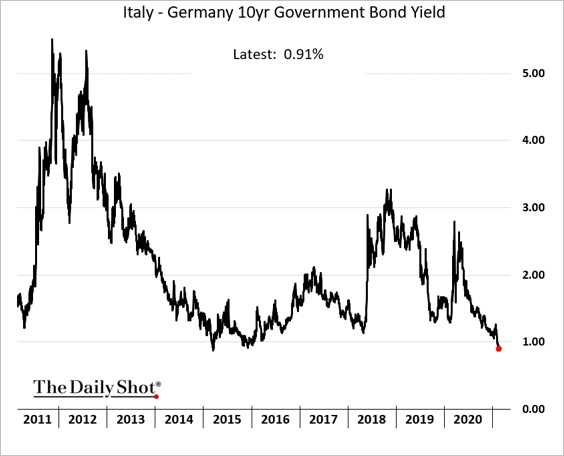
——————–
5. Brexit has forced a rerouting of trade routes between Ireland and the continent (see comment from the FT).
 Source: @financialtimes Read full article
Source: @financialtimes Read full article
6. Real yield differentials suggest continued upside for EUR/USD.
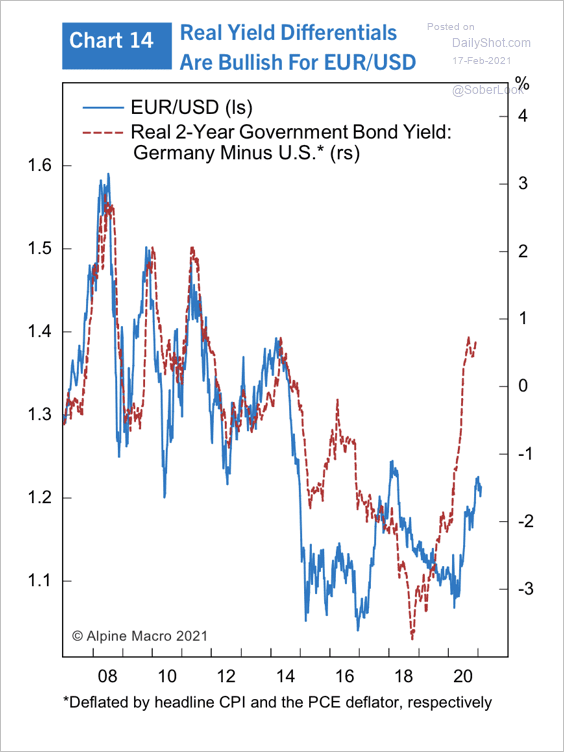 Source: Alpine Macro
Source: Alpine Macro
Back to Index
Japan
1. Japanese bond yields are climbing amid global debt selloff.
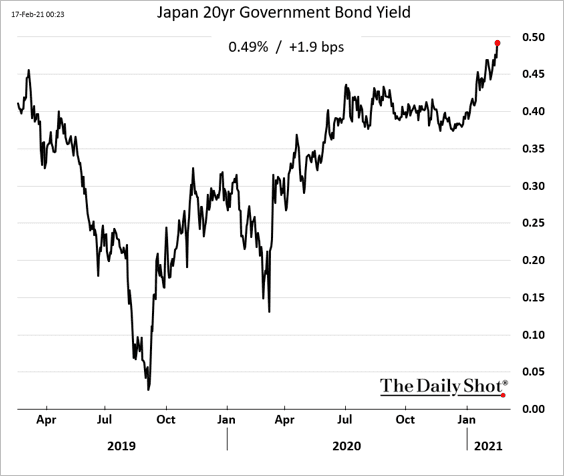
2. Exports accelerated, helped by demand from China.
 Source: @BLaw Read full article
Source: @BLaw Read full article
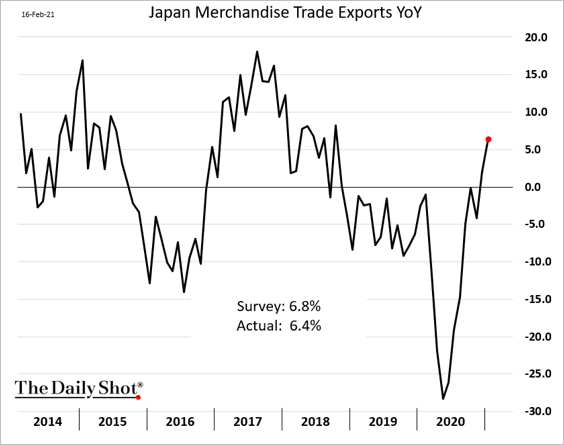
——————–
3. Machine orders surprised to the upside.
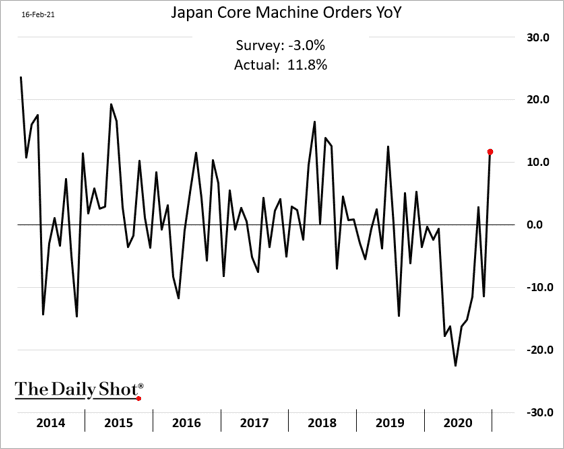
Back to Index
Asia – Pacific
1. Australian bond yields are moving higher.
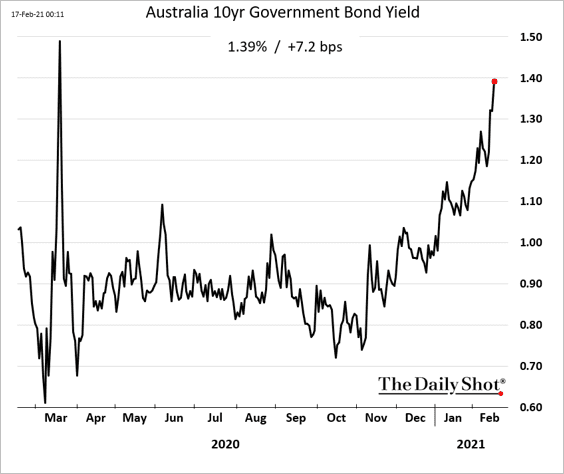
Australia’s yield curve steepening is outpacing other bond markets.
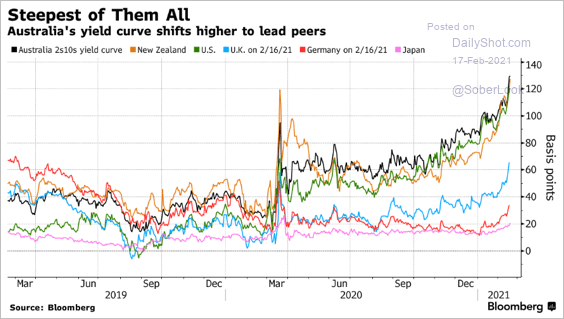 Source: Cormac Mullen, @TheTerminal, Bloomberg Finance L.P.
Source: Cormac Mullen, @TheTerminal, Bloomberg Finance L.P.
——————–
2. Alpine Macro expects further upside for AUD/USD.
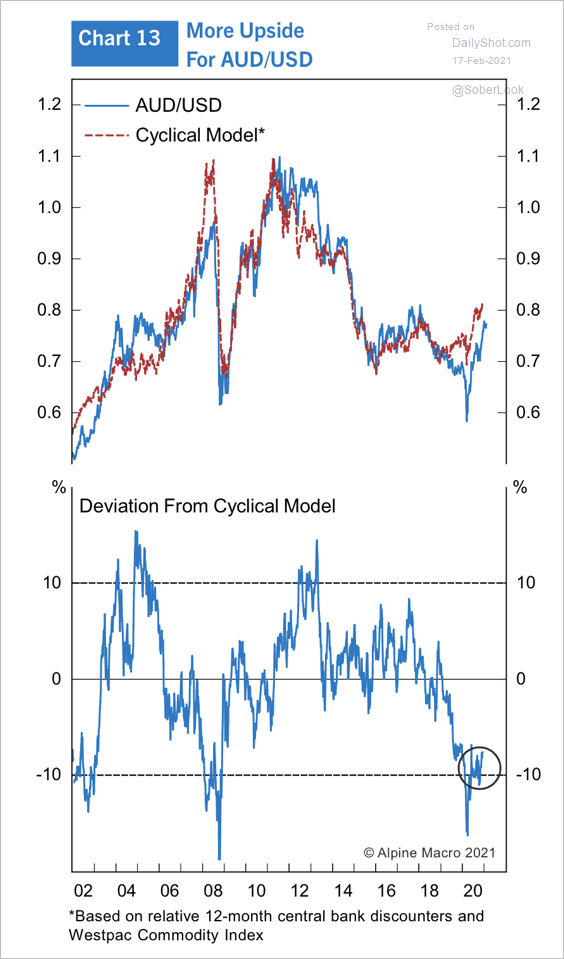 Source: Alpine Macro
Source: Alpine Macro
3. Singapore’s exports accelerated again last month.
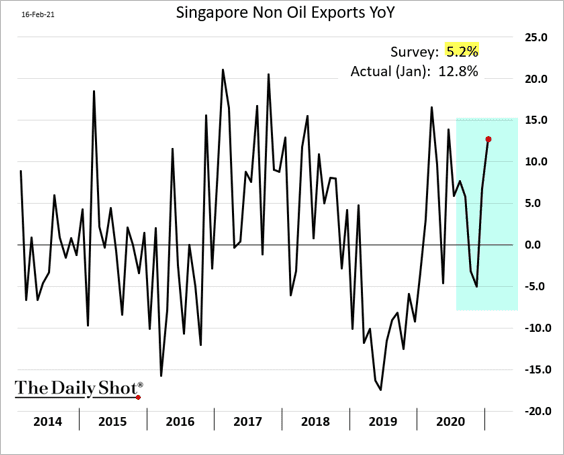
Back to Index
China
1. Due, in part, to some high-profile defaults, …
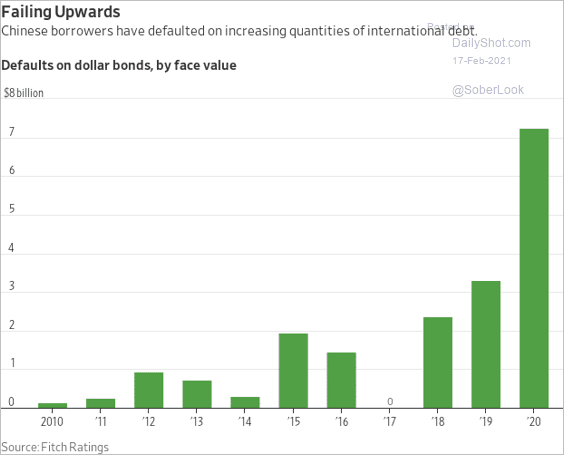 Source: @WSJ Read full article
Source: @WSJ Read full article
… China’s corporate high-yield debt has not rallied with the US peers.
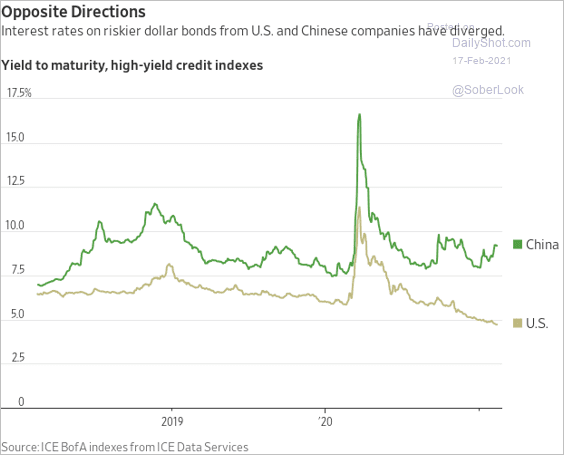 Source: @WSJ Read full article
Source: @WSJ Read full article
——————–
2. Here is the evolution of China’s equity market capitalization.
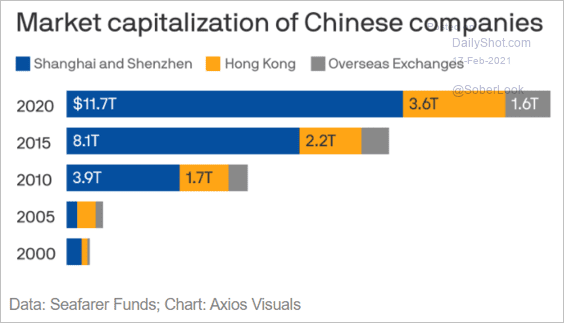 Source: @axios Read full article
Source: @axios Read full article
3. Mortgage rates have been drifting lower, and the overall mortgage market expansion has been slowing
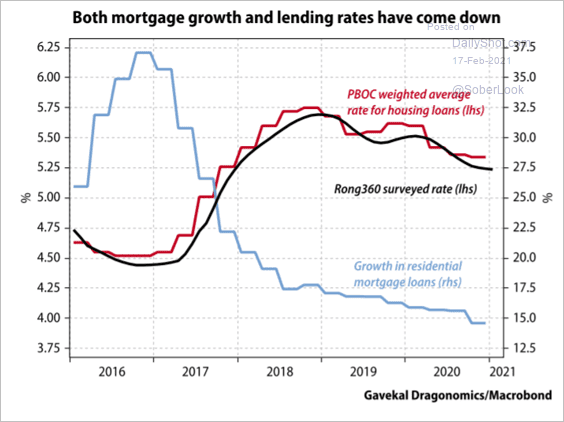 Source: Gavekal Research
Source: Gavekal Research
Back to Index
Emerging Markets
1. Russia’s producer prices are rising quickly. The central bank has become a bit hawkish lately amid signs of firmer inflation.
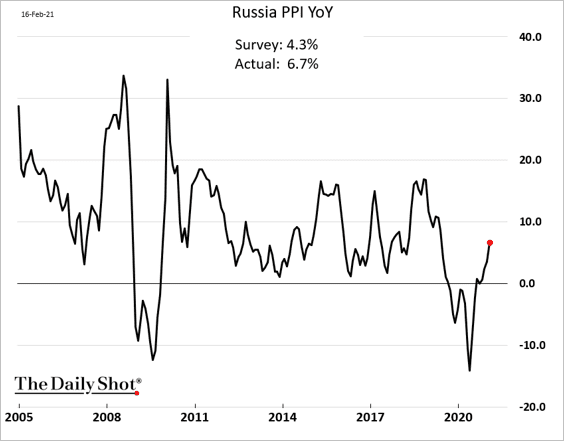
2. Israel’s Q4 GDP surprised to the upside.
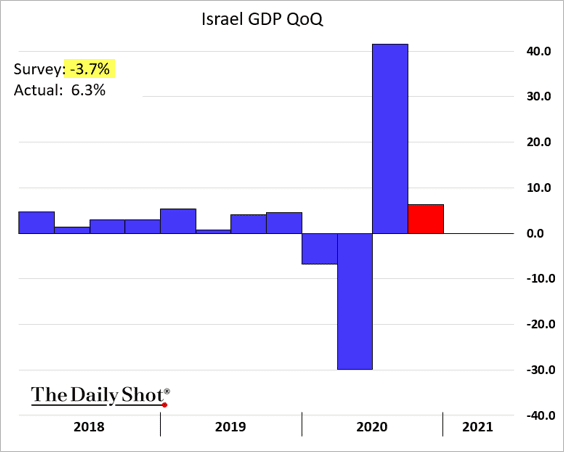
3. Turkish home prices are up 30% vs. a year ago (in lira terms).
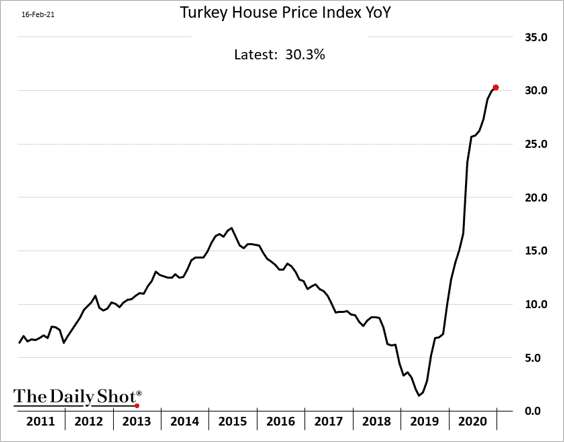
4. Nigeria’s consumer inflation is accelerating.
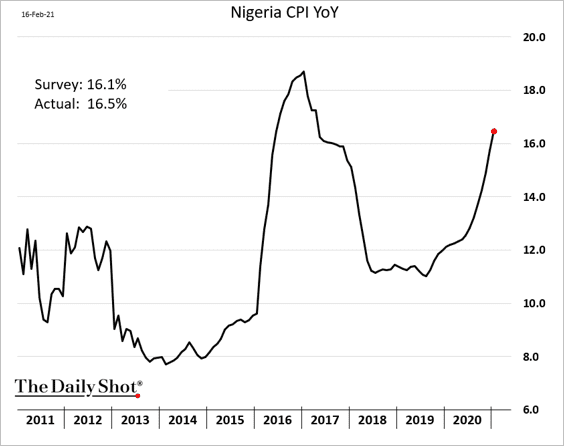
5. Current account balances are in much better shape than they were during taper-tantrum in 2013. Perhaps the selloff won’t be as severe after the next pullback in the Fed’s QE.
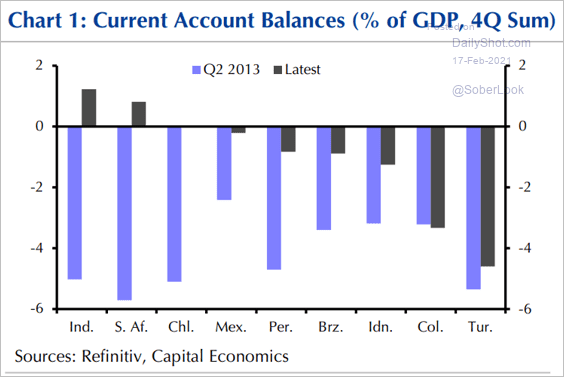 Source: Capital Economics
Source: Capital Economics
6. Dollar-denominated EM bonds are selling off with Treasuries.
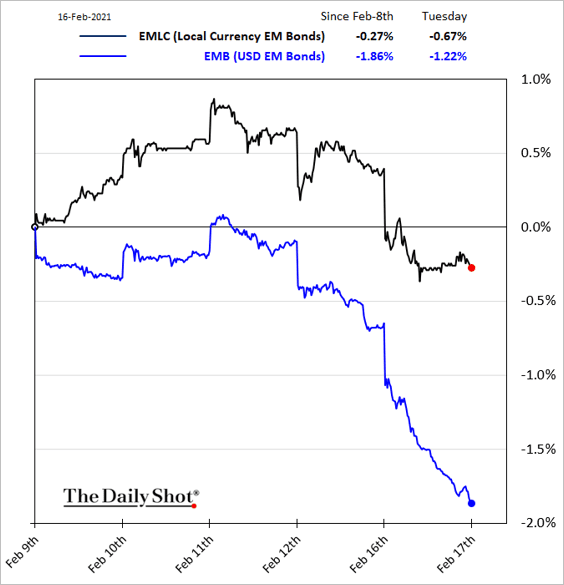
Back to Index
Cryptocurrency
1. Bitcoin broke through resistance at $50k.
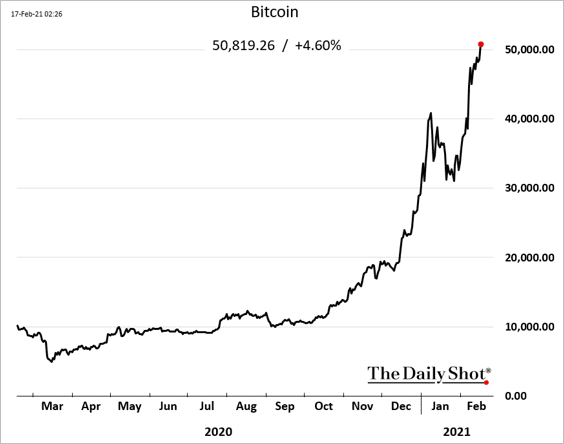
2. This chart shows the 90-day Sharpe ratio of Bitcoin and Ethereum versus traditional stock indices.
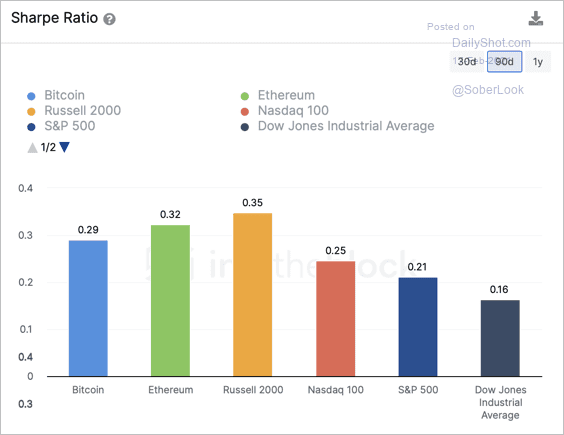 Source: IntoTheBlock
Source: IntoTheBlock
3. Here is the average intra-day move over one year for Bitcoin and Ethereum compared to popular stocks.
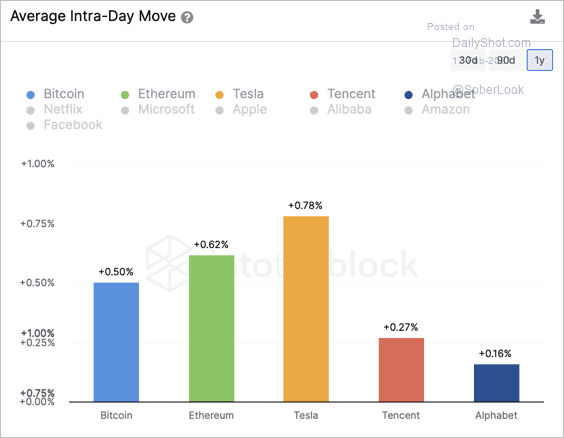 Source: IntoTheBlock
Source: IntoTheBlock
4. Bitcoin’s 30-day annualized volatility is at the highest level since the March 2020 crash.
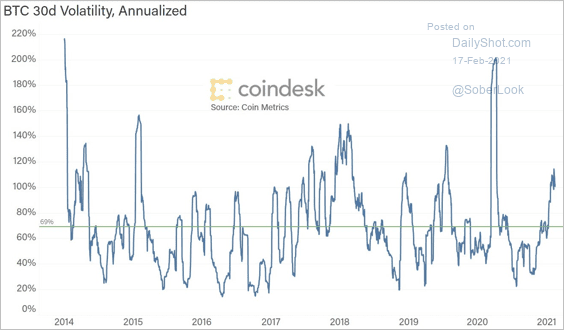 Source: @CoinDeskData
Source: @CoinDeskData
5. China’s crypto stocks have underperformed global peers.
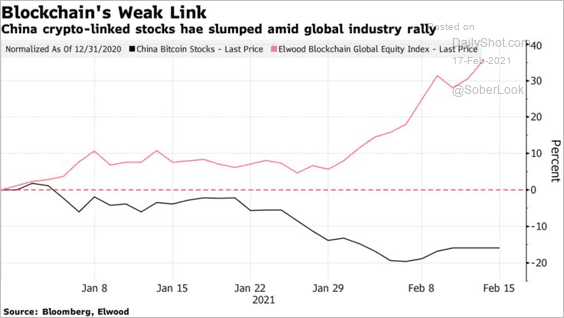 Source: @markets Read full article
Source: @markets Read full article
6. Bitcoin is popular in many emerging-market countries.
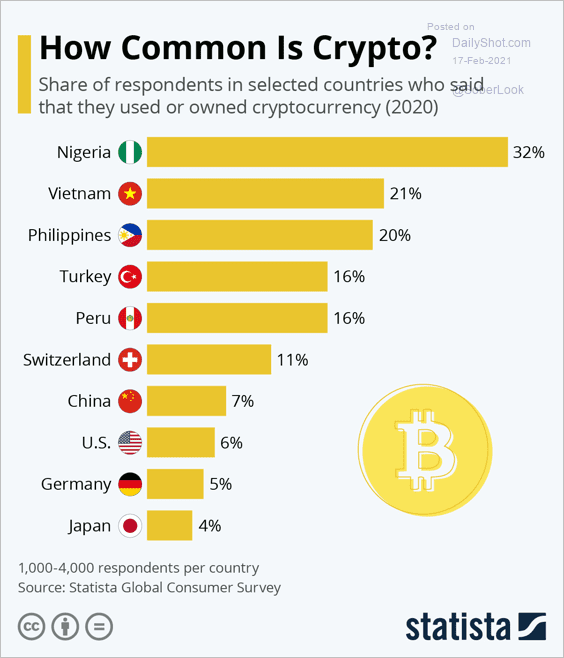 Source: Statista
Source: Statista
Back to Index
Commodities
1. Fund managers no longer see gold as overvalued.
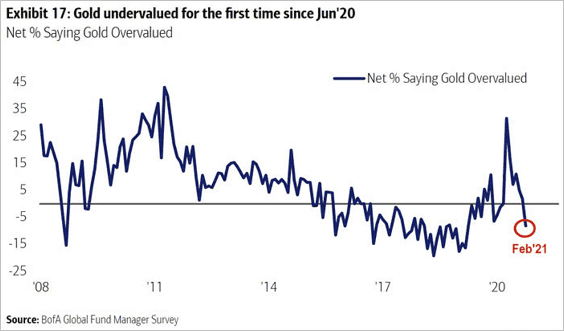
Gold has formed a death cross – a bearish signal, especially when combined with higher bond yields.
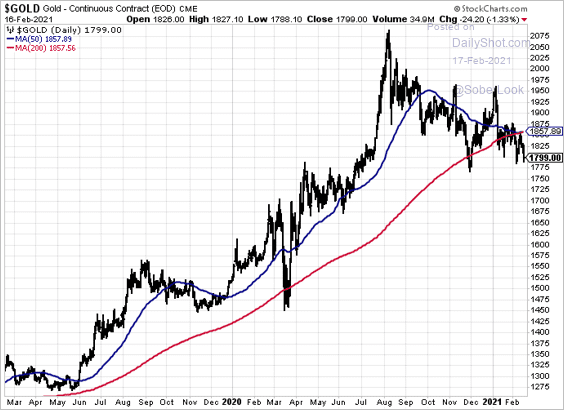
——————–
2. US lumber futures are at multi-year highs.
 Source: @WSJ Read full article
Source: @WSJ Read full article
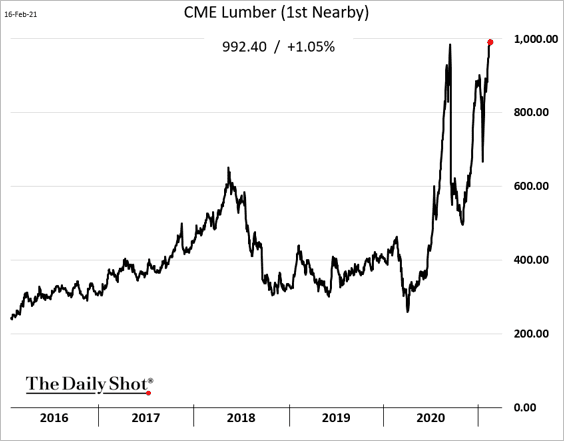
——————–
3. US cotton futures are breaking above long-term resistance.
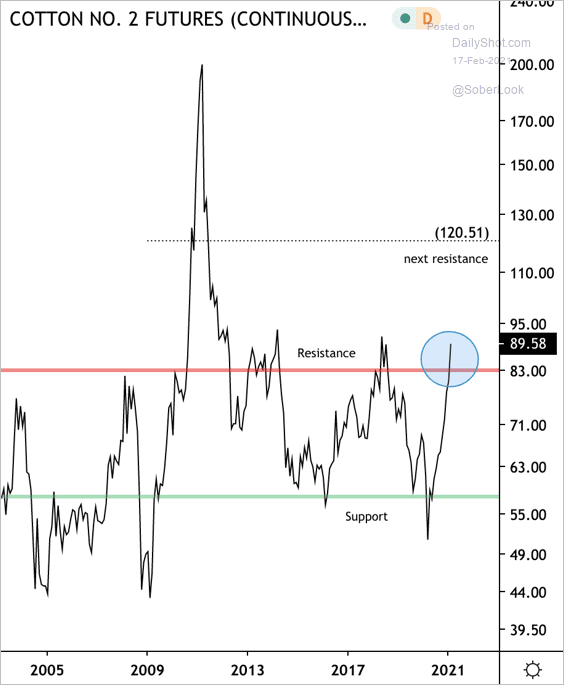 Source: Dantes Outlook
Source: Dantes Outlook
Back to Index
Energy
1. US oil output tumbled as a result of the frigid weather.
 Source: @markets Read full article
Source: @markets Read full article
Here is an estimate of the decline.
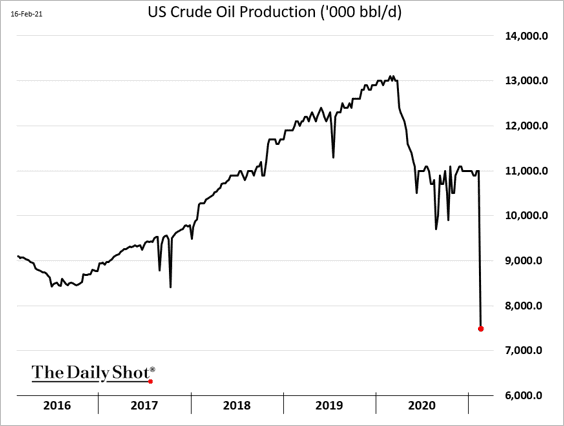
——————–
2. US refinery outages sent jet fuel prices sharply higher.
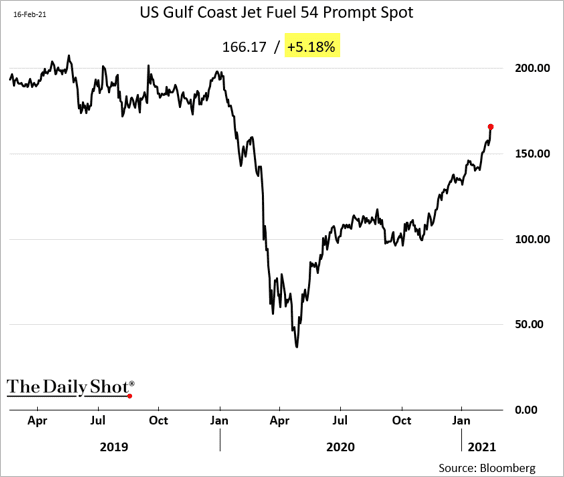
3. Natural gas output tumbled amid outages.
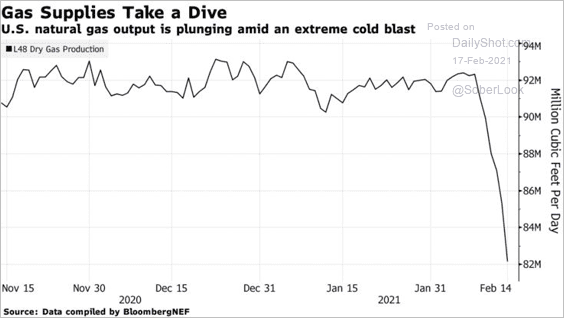 Source: @markets Read full article
Source: @markets Read full article
It’s by far the largest source of electricity production in Texas.
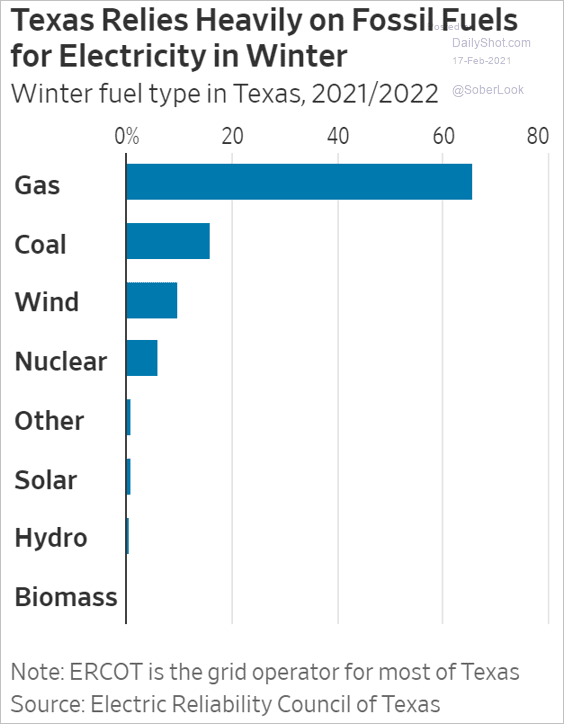 Source: @WSJ Read full article
Source: @WSJ Read full article
Many counties are still without power.
 Source: PowerOutage.US
Source: PowerOutage.US
——————–
4. Will Brent crude oil break above its long-term downtrend?
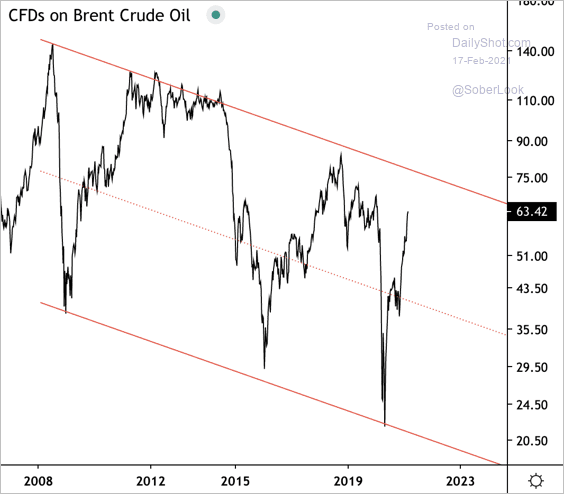 Source: Dantes Outlook
Source: Dantes Outlook
5. The International Energy Agency (IEA) can’t account for a few barrels of oil (see WSJ comment below):
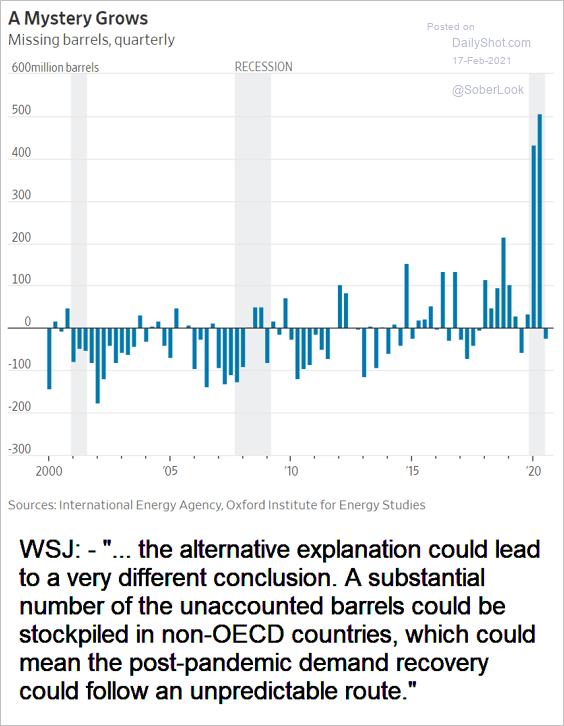 Source: @WSJ Read full article
Source: @WSJ Read full article
Back to Index
Equities
1. Fund managers surveyed by BofA are running record levels of risk.
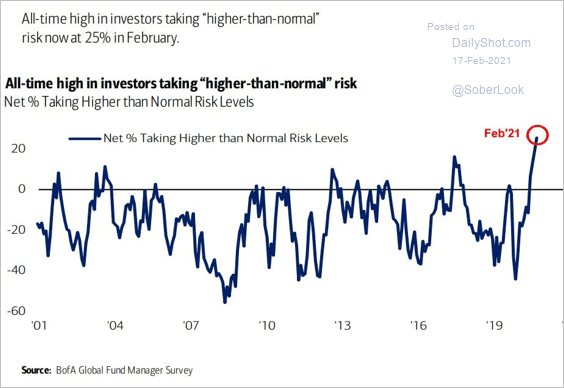 Source: BofA Global Research
Source: BofA Global Research
• Cash balances keep shrinking.
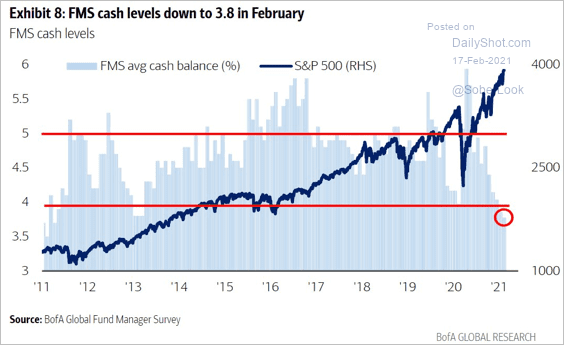 Source: BofA Global Research
Source: BofA Global Research
• Here is Goldman’s risk appetite index.

• The risk-on sentiment also shows up in the divergence between equity and government bond fund flows.
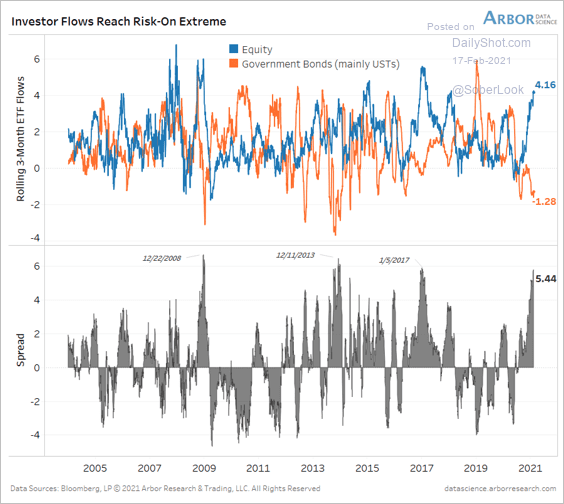 Source: Arbor Research & Trading
Source: Arbor Research & Trading
——————–
2. Increases in Treasury yields have generally been accompanied by stronger growth expectations and higher earnings estimates.
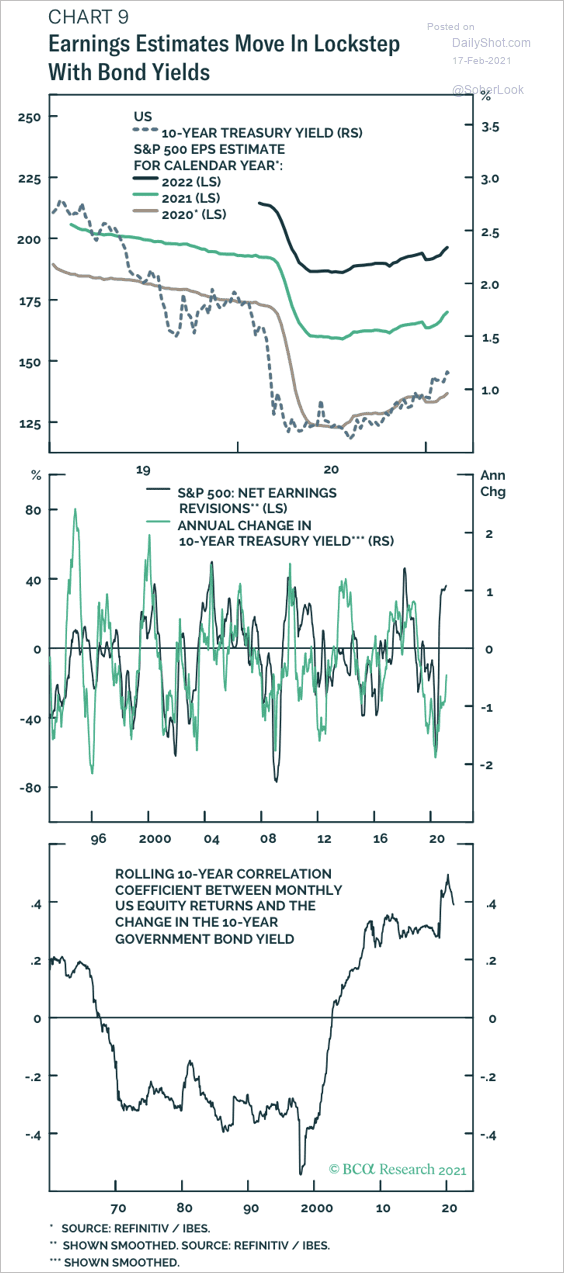 Source: BCA Research
Source: BCA Research
3. Companies with substantial sales in China continue to outperform global peers.

4. Small-cap outperformance tends to be correlated with Treasury yields.
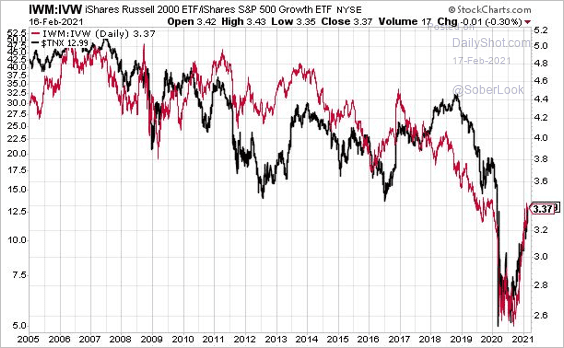 Source: Anastasios Avgeriou
Source: Anastasios Avgeriou
The rally in small caps has been impressive.
• The Russell 2000 index divided by its 200-day moving average:
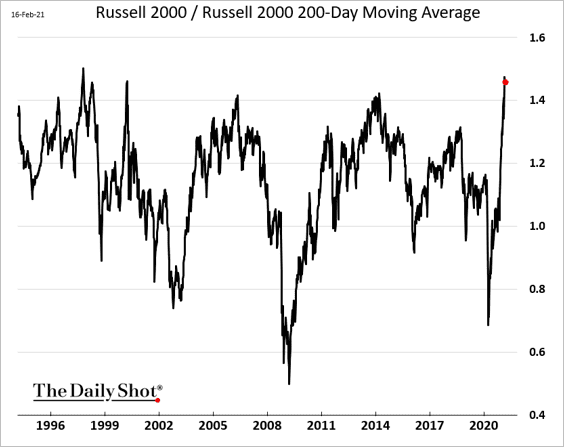
• The number of Russell 2000 firms above their 200-day moving average:
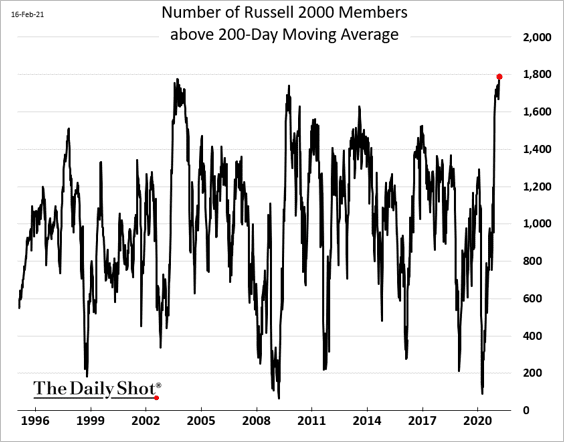
——————–
5. Penny stock activity has been extraordinary.
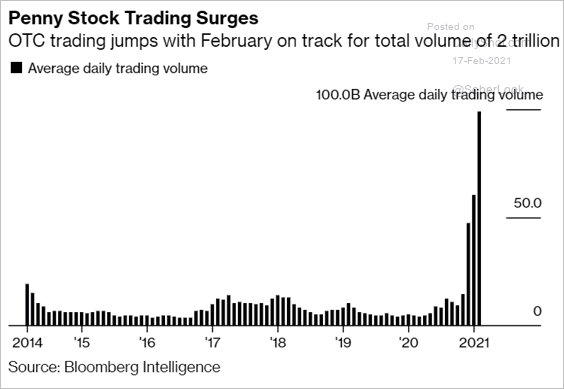 Source: @markets Read full article
Source: @markets Read full article
6. A smaller percentage of listed companies with a $250mm market cap or higher are profitable.
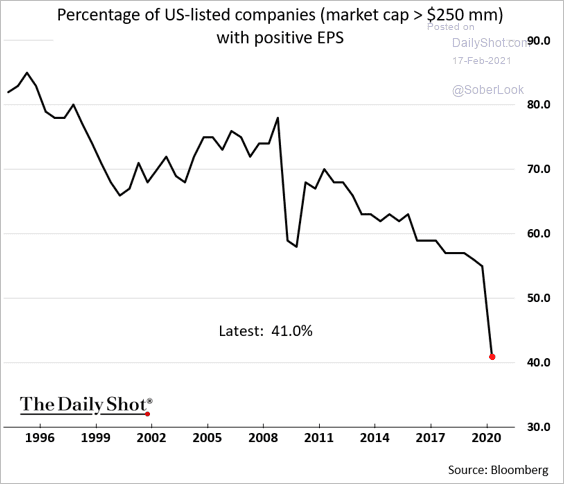 h/t @LizAnnSonders, @Bloomberg
h/t @LizAnnSonders, @Bloomberg
7. US value stocks trade at similar valuations to international shares.
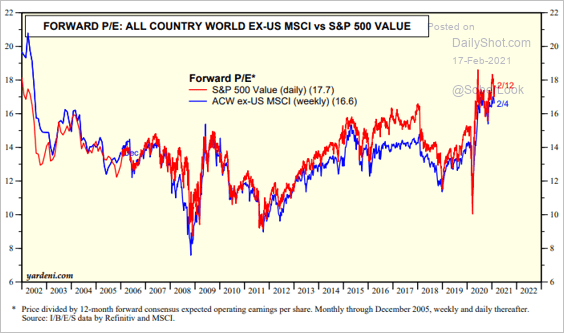 Source: Yardeni Research
Source: Yardeni Research
Back to Index
Credit
1. Junk bond yields continue to hit record lows.
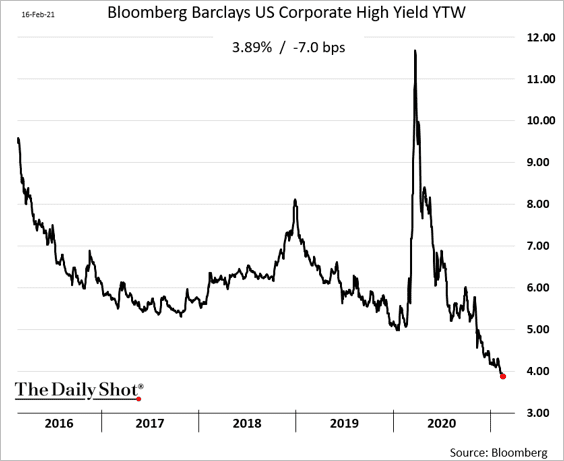
Here is the high-yield CDX spread (“index” of credit default swaps).
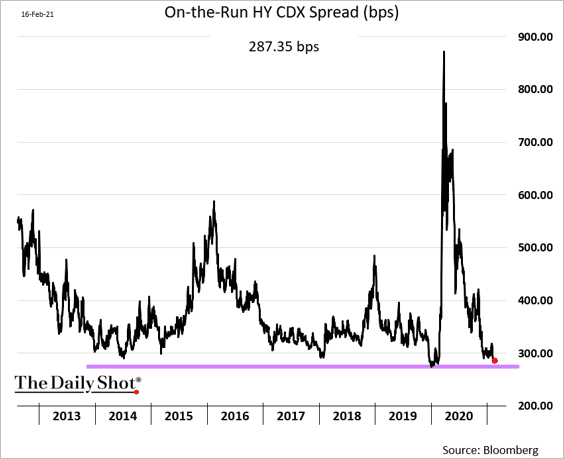
——————–
2. The most leveraged companies have been quite successful in tapping capital markets recently.
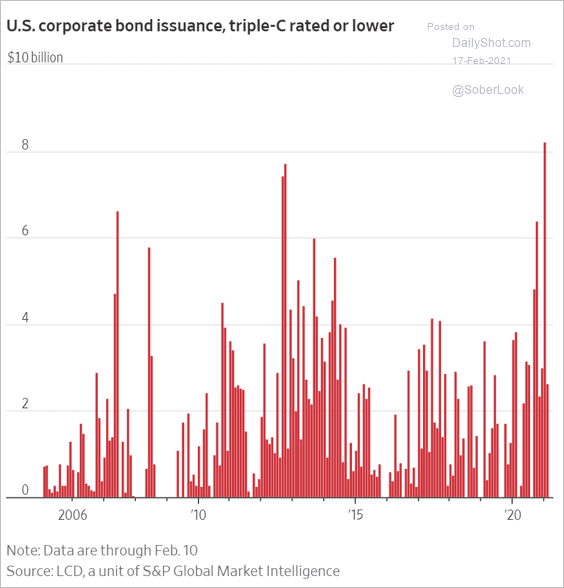 Source: @WSJ Read full article
Source: @WSJ Read full article
3. According to LPL Research, leveraged loans offer the best return per unit of interest rate risk (because these are floating rate instruments).
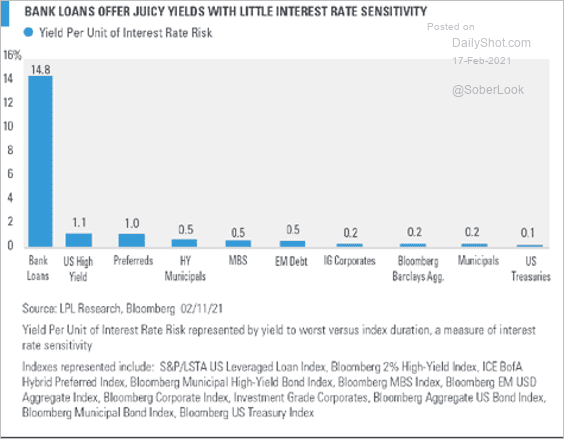 Source: LPL Research
Source: LPL Research
Back to Index
Rates
1. The short end of the Treasury curve has been steepening, …
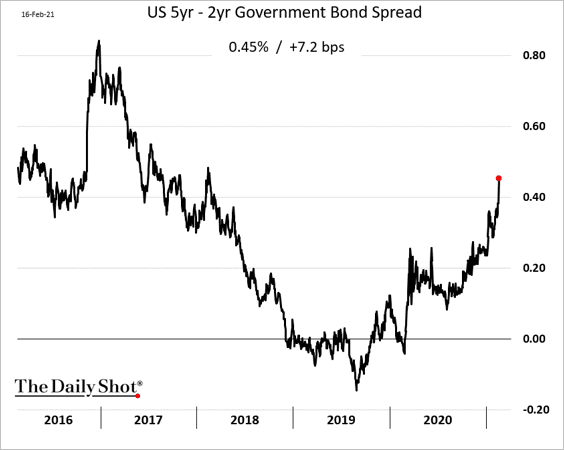
… as the market recalibrates the timing and the pace of the Fed’s rate hikes (chart below shows rates implied by 3-month LIBOR futures).
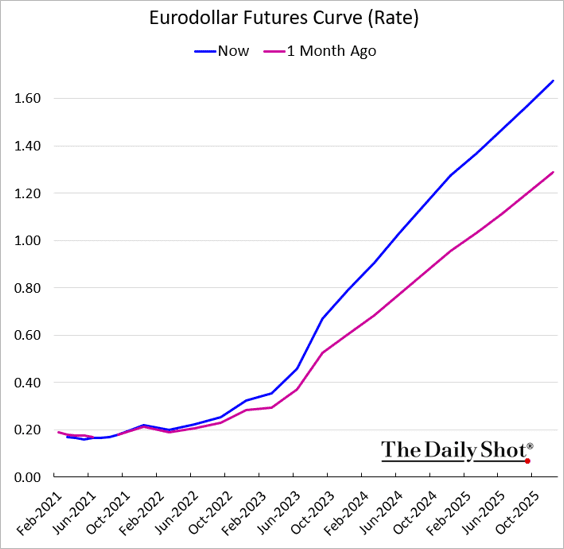
——————–
2. The yield curve slope has been correlated with the “reopen” basket of stocks’ relative performance.
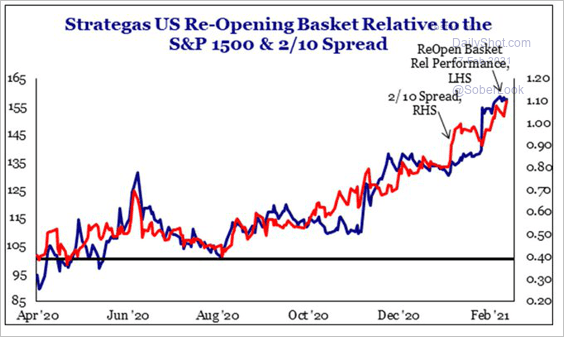 Source: @StrategasRP
Source: @StrategasRP
3. Treasury implied volatility jumped as bonds come under pressure.
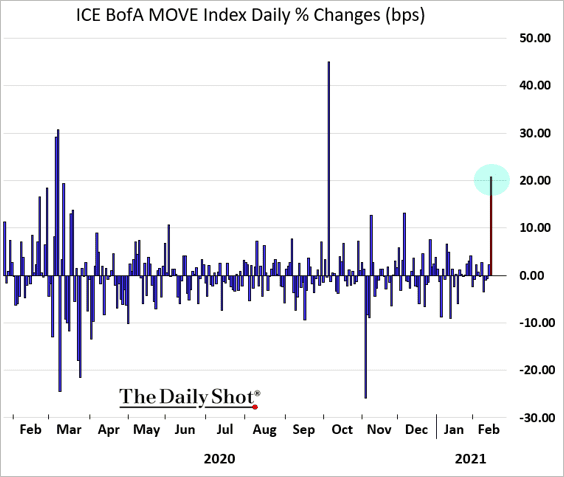
4. The recent recovery in breakevens (inflation expectations) have outpaced the increase in oil prices
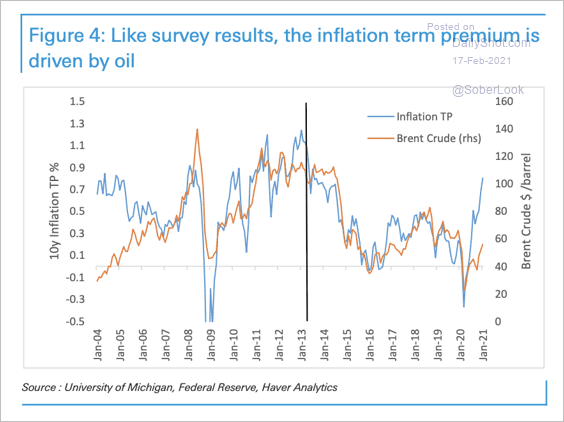 Source: Deutsche Bank Research
Source: Deutsche Bank Research
5. Forward Treasury yields are still below primary dealers’ projections.
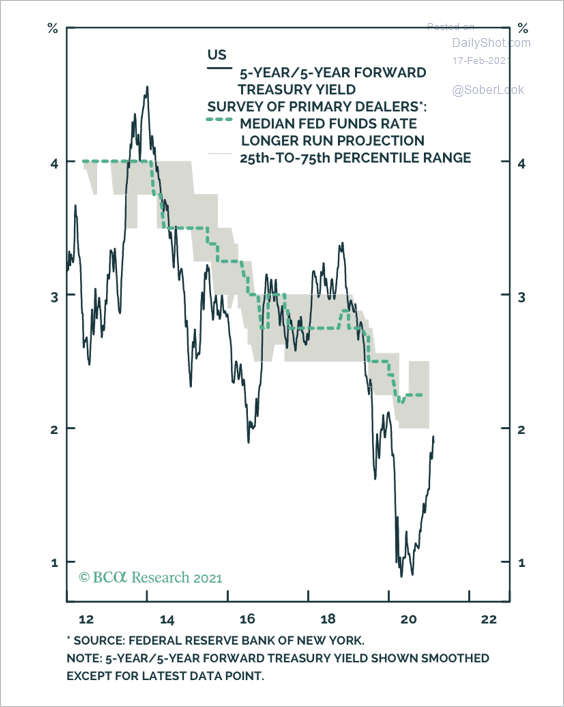 Source: BCA Research
Source: BCA Research
Back to Index
Global Developments
1. Global financial flows held up well last year, but foreign direct investment (FDI) slumped.
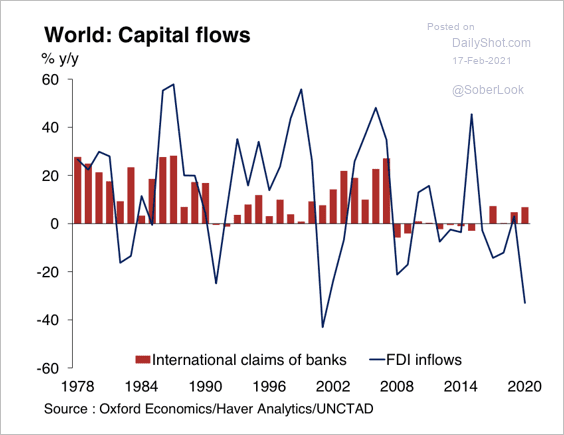 Source: Oxford Economics
Source: Oxford Economics
Oxford Economics expects a recovery in FDI, especially given recent strength in China.
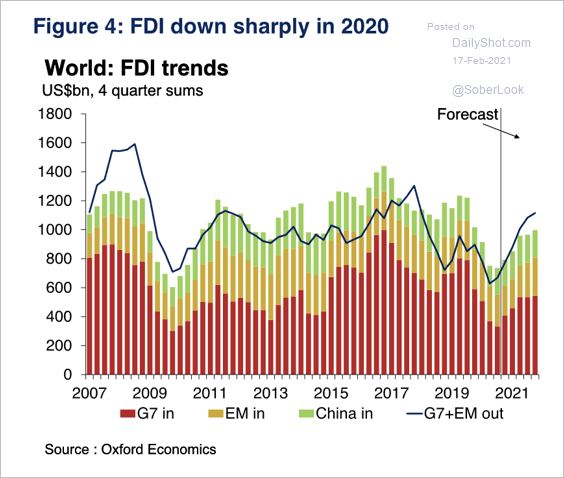 Source: Oxford Economics
Source: Oxford Economics
——————–
2. Analysts continue to question the official estimates of slack in the economy. If the amount of slack has been significantly underestimated, additional stimulus is less likely to fuel inflation.
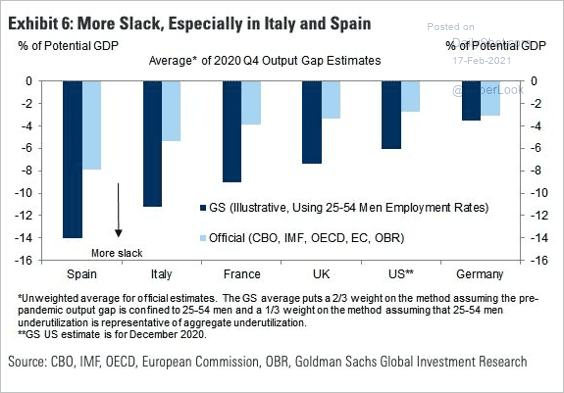 Source: Goldman Sachs, Octavian Adrian Tanase
Source: Goldman Sachs, Octavian Adrian Tanase
Back to Index
Food for Thought
1. The impact of chip shortage on the auto industry (see overview):
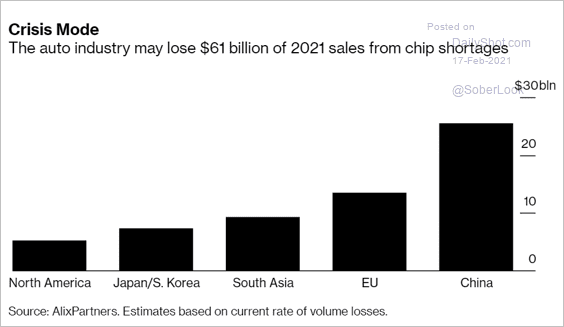 Source: @technology Read full article
Source: @technology Read full article
2. Auto recalls:
 Source: Statista
Source: Statista
3. US bank branch closings:
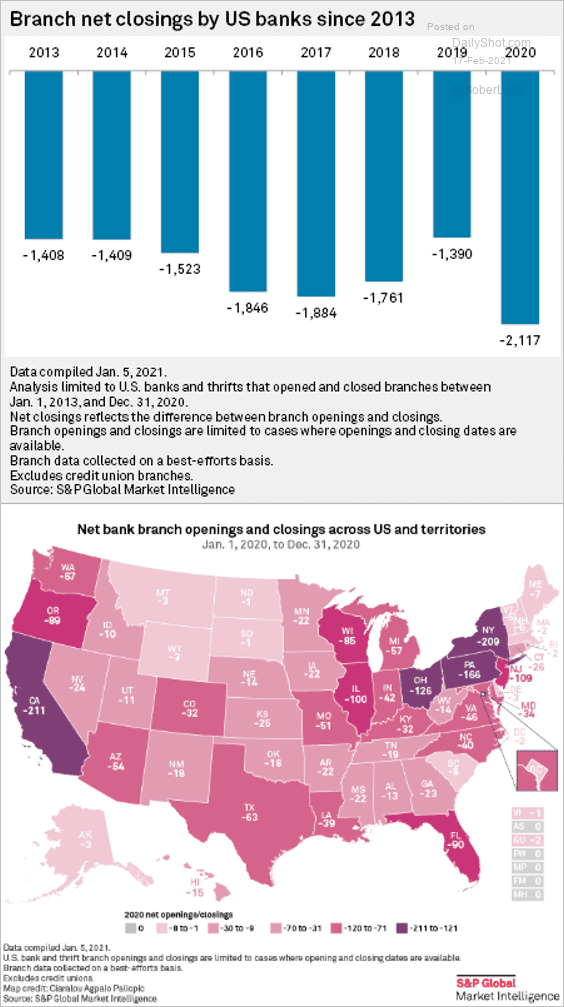 Source: S&P Global Market Intelligence
Source: S&P Global Market Intelligence
4. Whistleblowing tips to the SEC:
 Source: @chartrdaily
Source: @chartrdaily
5. Americans’ assessment of their financial situation:
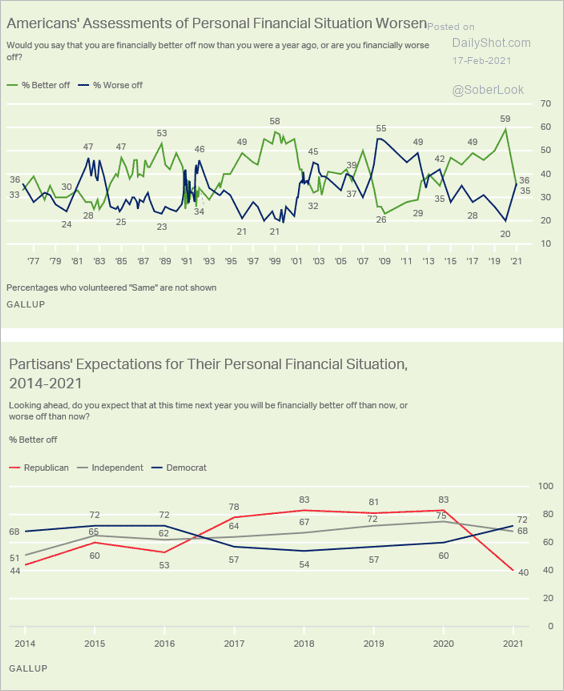 Source: Gallup Read full article
Source: Gallup Read full article
6. US population over 65:
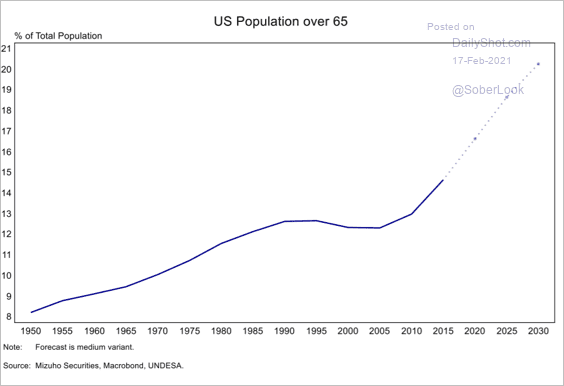 Source: Mizuho Securities USA
Source: Mizuho Securities USA
7. English proficiency in Europe:
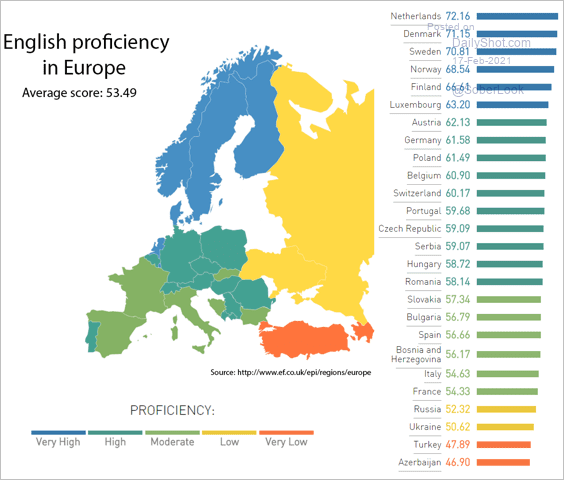 Source: EF Education First
Source: EF Education First
8. The average age of COVID hospitalizations in Israel:
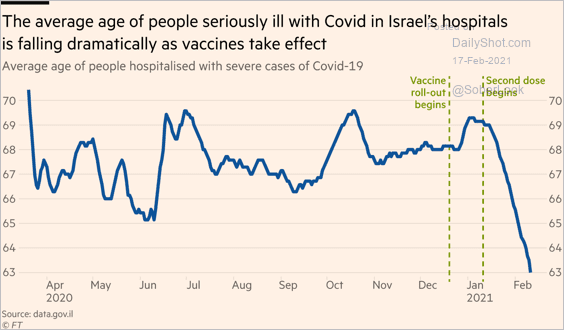 Source: @financialtimes
Source: @financialtimes
9. WW-II territory control over time:
 Source: 5KNA
Source: 5KNA
——————–
Back to Index
